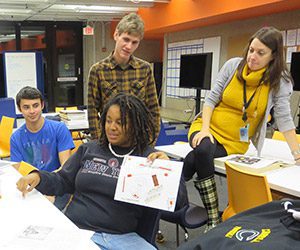Over the last several years, an area of focus in the education field has been to create pathways for youth to connect their learning experiences with their interests and future career opportunities–the idea being that students will be more engaged and invested in their education if it is relevant to them. Many of these pathways include out-of-school time (OST) efforts, such as mentorship and internship programs. A burgeoning area of study within the informal learning space is about how today’s youth connect and build social capital in OST environments, and then extend those positive experiences to other areas of their lives to continue building skills and knowledge.

To explore how youth leverage their relationships, or act as knowledge brokers across different learning environments, SRI Education conducted a research study in partnership with ARTLAB+, an afterschool program at the Hirshhorn Museum and Sculpture Garden, part of the Smithsonian Institution in Washington, D.C. This particular program was intriguing because it is a free, drop-in program with no pre-requisites for participation in its wide variety of offerings. It also attracted an ethnically and economically diverse spectrum of student participants and mentors. SRI researchers and the program directors wanted to understand what kept the students engaged in this program, even though it had no commitment requirements, and what the students took from this program into other aspects of their lives, such as skill development, interest development, and social relationships and connections.
Partnering with the program directors, SRI researchers used social network analysis, a survey-based method for understanding the relationships that were cultivated in this program and then extended into other learning environments. The students filled out a survey in which they named people they interacted with on a weekly basis, and then provided details on the different environments where these interactions took place, whether it was at home, at school, in the program, or another setting. The students were then asked a variety of questions about those people regarding the nature of their relationships. When analysis of the personal networks was complete, researchers returned to the program and conducted follow-up interviews with each student, where their network results were explained in detail.
The results from this research study, which will be presented at the upcoming AERA conference, were compelling and outlined many of the ways that youth utilize their peers and mentors to build new opportunities for future careers and academic pursuits, as well as build their social networks to support their interests in multiple settings.
Across the different activities that students were involved within the program, the research found their preference was to seek help from their peers, as opposed to searching for help on the Internet—underscoring the inherent value to the social process of learning. The students actively sought each other out because they knew they could learn from their peers through engaging dialogue and thinking about challenges differently to find solutions to problems, as opposed to one-way receptive learning through watching a video, for example. And, because the students asked questions of each other, there was a mutual respect and appreciation for the knowledge that the students had in the program.
Students also extended their social relationships beyond the program. For example, one group of students who had a common interest in digital photography decided to explore what a career in photography would potentially entail. They formed their own company, self-designated their individual roles based on different strengths, created a portfolio that they advertised, and brought this activity into other spheres of their lives. Other students extended their activities beyond the program by utilizing the program’s mentors to attain internships and work.
In addition, the research confirmed the program developers’ belief that learning must be relevant and connected to as many real-world applications and settings as possible. Analysis from interviews with students found that when they saw how a certain set of skills were transferable across settings and in different situations, they were more interested in learning these skills and becoming an expert in these skills. From a social network perspective, the students who felt the skills or activities they were involved in at the program were transferable were more likely to develop networks of peers and mentors with the same interest.
This research study brought to light the qualities of ARTLAB+ that made it a successful learning environment and highlighted the importance of social capital for youths. Moving forward, SRI is looking to expand this work by using this methodology to test the efficacy of programs that purport to match students with mentors or larger internship experiences – ultimately understanding whether the burgeoning approach of intentionally designing learning pathways for youths can achieve the goal of enabling academic and career success.
Photo credit: ARTLAB+


